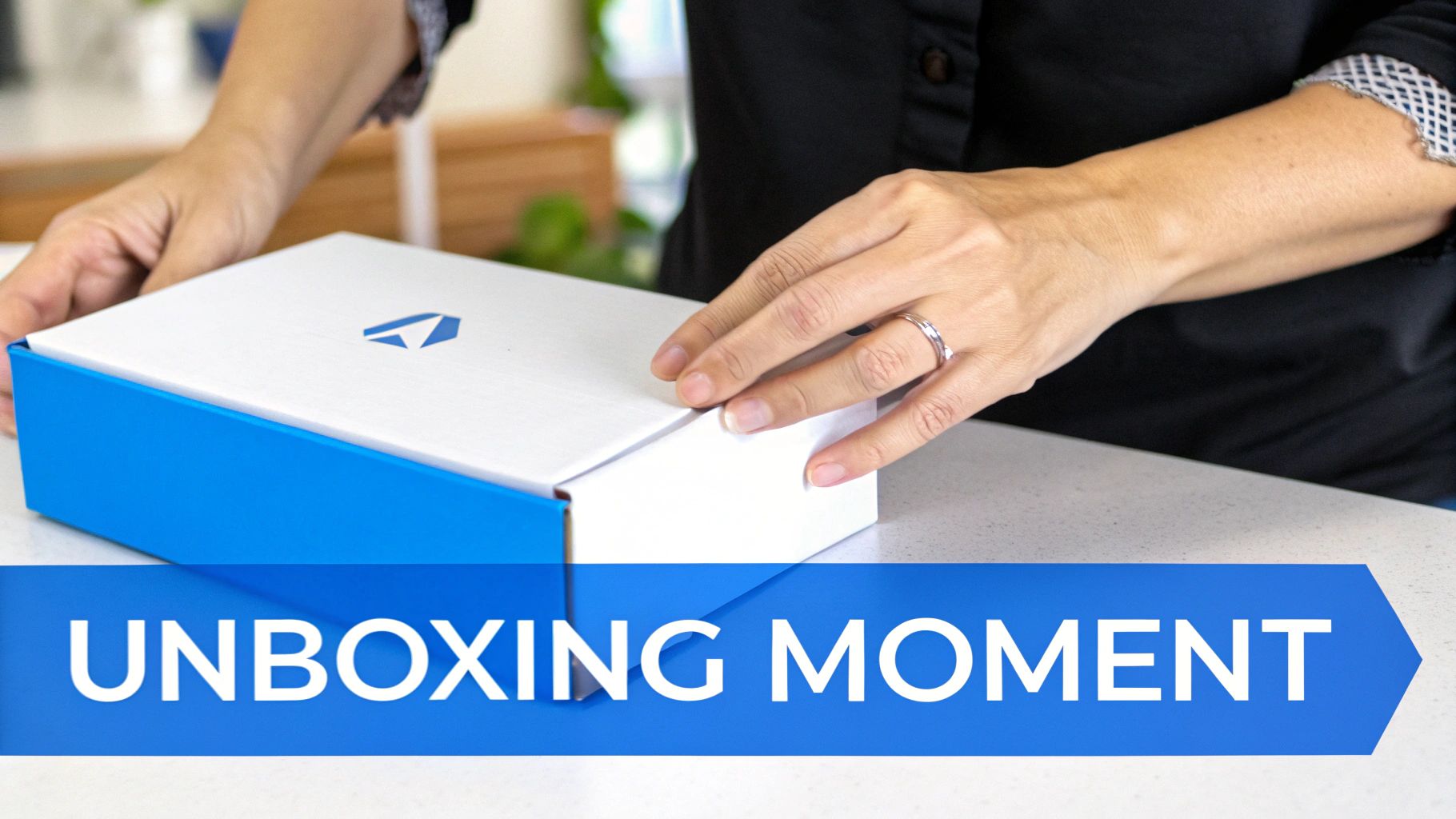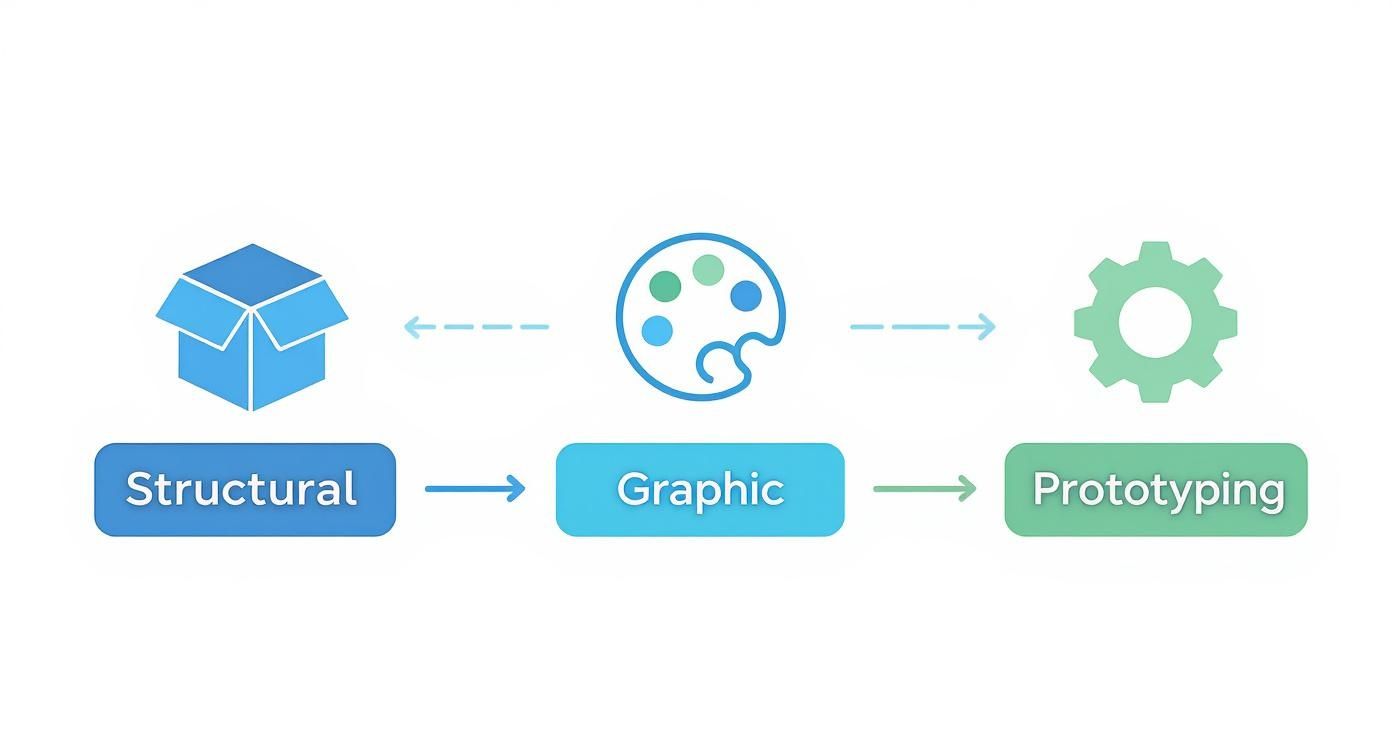So, what exactly is a package design service?
Think of it as bringing in a specialized architect for your product. You wouldn't build a house without a blueprint that considers both aesthetics and structural integrity, right? A package design service does the same for your brand's physical presence, blending graphic design, industrial engineering, and brand strategy to create something that’s both beautiful and functional.
It's about transforming a simple box into your most powerful marketing tool. The end game is to craft a memorable unboxing experience that not only protects what's inside but also absolutely delights your customer from the moment it lands on their doorstep.
Forget thinking of them as just a vendor you hire to make a pretty box. A great package design service is a strategic partner. They’re responsible for creating the very first tangible connection a customer has with your brand, and in a sea of brown boxes, that first impression is everything.
This isn't a single skill but a mashup of several disciplines all working toward one goal: creating a package that sells. For any brand shipping physical products, investing in professional design moves you past basic functionality and into the realm of actively influencing customer perception and buying behavior.
Modern package design is a complex job that pulls together a few critical functions. When done right, these pieces work in harmony to support your business from the warehouse shelf to the customer's home.
The demand for this combination of skills is exploding. The global market for these services is expected to jump from an estimated USD 26.64 billion in 2025 to around USD 35.06 billion by 2032. This surge is fueled by the relentless growth of e-commerce and a growing consumer preference for packaging that is both sustainable and visually appealing.
At its core, a comprehensive package design service makes sure your product's "outfit" is just as thoughtful and well-made as the product itself. It’s a non-negotiable step in building a strong brand identity that starts the moment a customer receives their order. To learn more about the basics, check out our complete guide to e-commerce packaging.

In e-commerce, your packaging is so much more than just a box. Think of it as your digital storefront, your first handshake, and your silent salesperson all rolled into one. It’s the very first physical interaction a customer has with your brand, making it a critical moment that can shape their entire perception.
A professional package design service gets this. Their job goes way beyond making things look pretty; their expertise has a direct impact on your bottom line. Expertly designed packaging drastically cuts down on shipping damages and costly returns, protecting both your products and your profits. But that foundational protection is just where the value begins.
The real magic of great packaging lies in crafting a memorable "unboxing experience." This isn't just about ripping open a box. It's about creating a shareable moment that can turn a first-time buyer into a vocal brand advocate on social media.
It’s the thoughtful details that transform a simple delivery into something special. These little touches work together to build anticipation and genuine delight:
These elements do more than just protect what’s inside. They boost the product's perceived value, build customer loyalty, and spark the kind of priceless user-generated content that fuels organic growth. A key part of this process now involves leveraging 3D product rendering, which helps businesses visualize and perfect their packaging before a single box is ever produced.
This focus on the unboxing moment is not just a trend; it's a fundamental shift in how direct-to-consumer brands connect with their audience. It's about making the customer feel valued from the second the package arrives at their door.
This push toward experience-driven packaging is clearly reflected in market growth. In the United States, the packaging and labeling services industry has exploded, thanks in large part to the surge in online shopping.
Revenue grew at a compound annual rate of about 8.5% between 2020 and 2025, hitting an estimated USD 17.8 billion. This growth highlights just how critical it is for brands to find that sweet spot between protection, cost, and brand presentation.
Ultimately, bringing in a package design service is an investment in your brand’s future. It ensures your first impression isn’t just good but truly memorable, creating a lasting connection that drives repeat business and word-of-mouth marketing. To learn more, check out our guide on how custom packaging helps your e-commerce business succeed.
A top-tier package design service is so much more than just a team of graphic designers making pretty boxes. Think of it as a specialized workshop where art, engineering, and market science get fused together. To really get why this matters, you have to look under the hood at the core pieces that turn a simple container into a powerful brand-building tool.
These services aren't just a niche industry; they're the engines driving a massive market. The whole packaging design sector was valued at around USD 15 billion in 2025, and it's expected to grow at a steady clip of 7% every year through 2033. This boom is powered by giants like the food and beverage industry, but also by brands in cosmetics and electronics where design is everything—both for keeping products safe and for creating that premium, must-have feel.
Long before anyone even thinks about a color palette or a font, the real work begins with structural design. This is the nuts-and-bolts engineering of your package. It’s all about function, durability, and creating a blueprint that guarantees your product shows up in one piece and gives your customer a great experience.
A seasoned design service will obsess over a few key things here:
Once the physical structure is solid, the graphic design team steps in to breathe life and personality into the package. This is where your box becomes a silent storyteller, shouting your brand’s values from the shelf and making an emotional connection with your ideal customer. It’s a careful process of choosing colors, typography, and imagery that just click.
A great design doesn't just decorate a box; it creates an identity. It's the difference between a generic container and a memorable brand moment that customers want to share.
This visual language needs to be consistent everywhere your brand appears, turning your packaging into a familiar and trusted friend.
But modern services go way deeper than just the basics. Today, understanding sustainability is a huge part of the game. This means sourcing eco-conscious materials like FSC-certified paper, compostable mailers, or soy-based inks. If you're in the beauty space, for example, knowing the ins and outs of eco-friendly cosmetic packaging is a fantastic place to start.
On top of that, leading agencies use advanced prototyping to take all the guesswork out of the equation. They can create photorealistic 3D renders for quick visual checks and then produce physical mockups. This lets you actually hold your packaging, test how it feels and functions, and tweak things before you commit to a huge, expensive production run. It’s all about making sure the final product is absolutely perfect.
When you're evaluating a package design service, it helps to know which of these components are most important for your specific goals.
This table can help you prioritize what to look for based on your industry and what you're trying to achieve.
Ultimately, the best services integrate all these components seamlessly. Understanding each part helps you ask the right questions and find a partner who can deliver packaging that not only protects your product but elevates your entire brand.
Getting from a spark of an idea to a finished, physical box can feel a bit mysterious. But the truth is, working with a package design service isn't some chaotic creative free-for-all. It's more like building a custom home; you don’t just show up on moving day and hope for the best. There's a structured process with clear milestones that makes sure the final product is exactly what you had in mind.
A professional design process gives you a reliable roadmap, helping you sidestep costly mistakes and keeping everyone on the same page. When you understand the stages, you can set realistic timelines, give the right feedback at the right time, and just plain work better with your creative partners.
This infographic breaks down the core phases of a typical project, from the nitty-gritty structural engineering to the final graphics.

As you can see, it's a careful balance. It blends the technical side of things (structure) with creative expression (graphics) and practical testing (prototypes). This ensures you end up with something that not only looks great but actually works.
This is where it all begins—the foundation for the entire project. It’s less about picking colors and fonts and more about deep strategic alignment. Your design team will dive in with you to get a handle on your brand’s core values, who your customers really are, and what the competition is up to.
Key moves in this phase include:
This stage is absolutely crucial. A solid strategy keeps the project from wandering off track later. It makes sure every design choice isn't just about looking good, but is firmly rooted in smart business goals. For a deeper look, check out our guide on eCommerce packaging design tips to boost your brand.
With a clear strategy locked in, the creative fun begins. This is where ideas start to take real shape, moving from abstract thoughts to things you can actually see and imagine. The design team will brainstorm, sketch out initial concepts, and put together mood boards to nail down a visual direction.
From there, it’s time to make things real with prototyping. Using advanced software, designers create 3D renders that let you spin the package around and see it from every angle. Then, they’ll often create physical samples or mockups.
This hands-on step is priceless. It’s your chance to feel the materials, test out the opening mechanism, and see how your product physically fits inside—all before you commit to a massive production run.
The home stretch is all about collaboration and getting the details just right. Based on your feedback from the prototypes, the design team enters a refinement loop. They'll make small, iterative tweaks to both the structure and the graphics until every single element is perfect.
Once you give the final thumbs-up, the agency preps the final files. This includes the finalized dieline—that’s the technical, flattened-out template your manufacturer will use to cut and fold the packaging. This print-ready file is the blueprint that turns your approved design into thousands of identical, perfect boxes, ready to head out the door to your customers.
Alright, let's get down to the brass tacks of bringing your vision to life—the budget. Figuring out the cost for a package design service is one of the first questions on everyone's mind, but there’s no simple price tag.
Think of it less like buying a product off the shelf and more like commissioning a custom piece of art. The final number is always a blend of time, talent, and materials, tailored to what you specifically need.
So, what drives that cost? It boils down to a few key things: the project's overall complexity, the full scope of what you're asking for, the agency's depth of experience, and how many rounds of design revisions are baked into the process. A startup’s first mailer box will naturally land in a different ballpark than a luxury brand’s intricate, multi-part packaging experience.
To budget effectively, you need to get a handle on what really moves the needle on pricing. A simple label refresh is a world away from engineering a brand-new structural box with custom inserts and unique finishes.
Here are the main elements that will shape your quote:
Getting the most bang for your buck from a package design service isn't about finding the rock-bottom cheapest option. It’s about being efficient and crystal clear from the get-go.
One of the absolute best ways to control costs and avoid "scope creep" is to prepare a detailed creative brief before you even kick off the project.
A well-defined creative brief acts as your project's North Star. It aligns both teams on goals, deliverables, and success metrics from day one, preventing costly misunderstandings and endless revisions down the line.
Another pro tip: establish a single, decisive point of contact within your company. This simple step ensures feedback is clear and consolidated, which prevents conflicting opinions from derailing the project and tacking unnecessary hours onto the invoice.
Making smart choices about materials is also a huge part of managing your total project cost. For a detailed look, you can explore the pros and cons of popular packaging materials to see how different options impact not just your budget, but your brand's feel and sustainability goals, too.

Choosing the right agency is probably the single most important decision you'll make in this entire process. Think of this partner as more than just a designer—they become a temporary extension of your brand team, tasked with turning your vision into a physical, tangible asset.
Get it right, and you can seriously accelerate your growth. But the wrong choice can lead to frustrating delays, blown budgets, and a final package that just doesn't connect with your customers.
Start by digging into their portfolio. Look past the slick, pretty pictures and hunt for direct experience in your industry. An agency that makes beautiful, minimalist boxes for tech gadgets might not have a clue about the material constraints and regulatory hoops you have to jump through in the food and beverage world.
Then, get a feel for their process and how they communicate. A top-notch package design service won’t just disappear for weeks and come back with a "big reveal." They should have a clear, transparent workflow that keeps you in the loop. You need a partner whose rhythm matches yours, whether you thrive on daily check-ins or prefer a concise weekly summary.
Before you even think about signing a contract, you need to go in armed with a list of pointed questions. Their answers will tell you everything you need to know about their actual expertise and whether they're a true strategic partner or just another design vendor.
The goal is to find a partner who understands both the art of design and the science of manufacturing. They should be able to create something beautiful that can also be produced efficiently and cost-effectively.
Stepping into the world of professional package design is a big move, and it’s completely normal to have a few questions before you dive in. Thinking through the practical details—timelines, who owns what, and how manufacturing fits in—is what separates a smooth project from a bumpy one.
We get these questions all the time, so let's clear the air. Getting these details sorted out upfront builds a solid foundation for a great partnership, long before the first creative concept is even on the table.
This is the big one, and the honest answer is: it depends. But a good rule of thumb for a standard project is anywhere from 4 to 12 weeks.
So what pushes a project to one end of that spectrum or the other? Complexity is the main driver. If you're just refreshing a label on an existing box, you're looking at the shorter end of the timeline. But if you’re creating a completely custom, structurally engineered box with unique inserts, that takes more time for design, prototyping, and dialing in the details.
The other big factor is your team's feedback loop. The faster you can provide clear, consolidated feedback and approvals, the smoother and quicker the whole process will be.
The key takeaway is that complexity drives the timeline. The more components and engineering involved, the longer the process will be.
Yes, 100%. This is non-negotiable in any professional design engagement. Once the final invoice is settled, the keys to the kingdom are yours.
A reputable design service will hand over all the final, print-ready source files. These are typically Adobe Illustrator files that include the crucial dielines your manufacturer needs to produce the packaging correctly. This means you have the full intellectual property rights to use that design for production, on your website, in marketing—anywhere you need to, without restrictions.
Many of them can, and it’s a huge plus when they do. Experienced design agencies have spent years building relationships with printers and manufacturers they trust. They know who does good work, who hits their deadlines, and who specializes in certain materials or finishes.
While their primary job is design, they can often point you in the right direction with a few solid recommendations. Some even offer production management as an added service, ensuring the final product coming off the line looks exactly like the approved design. Definitely ask about this when you're vetting potential partners—it can save you a ton of headaches down the road.
At Simpl Fulfillment, we know that great packaging is just the beginning. Our experts handle everything from custom packaging design to same-day fulfillment, making sure your customers get an unboxing experience that builds loyalty. Learn more about how we can elevate your brand's logistics and presentation.